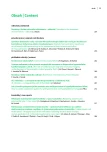The role of cardiovascular magnetic resonance imaging in the diagnosis of hypertrophic cardiomyopathy.
Part II
Authors:
Martin Pleva 1,2; Júlia Borová 1; Ilona Plevová 3; Jaroslav Januška 1; Margita Belicová 4
Authors‘ workplace:
Komplexní kardiovaskulární centrum Nemocnice Podlesí a. s., Třinec
1; Vaskulární centrum Vítkovické nemocnice, a. s., Ostrava
2; Ústav ošetřovatelství a porodní asistence LF OU, Ostrava
3; I. interná klinika JLF UK a UNM, Martin, Slovenská republika
4
Published in:
Vnitř Lék 2017; 63(4): 249-253
Category:
Reviews
Overview
Hypertrophic cardiomyopathy is currently understood as a group of diseases with left ventricular hypertrophy, which are not based on adaptive mechanisms. The first part of the review details the possibility of cardiac magnetic resonance in the diagnosis of sarcomeric forms of hypertrophic cardiomyopathy, the second part will focus on the possibilities of distinguishing the sarcomeric forms from their phenocopies.
Key words:
cardiac magnetic resonance – hypertrophic cardiomyopathy – phenocopies
Sources
1. Elliott PM, Anastasakis A, Borger MA et al. 2014 ESC Guidelines on diagnosis and management of hypertrophic cardiomyopathy: the Task Force for the Diagnosis and Management of Hypertrophic Cardiomyopathy of the European Society of Cardiology (ESC). Eur Heart J 2014; 35(39):2733–2779. Dostupné z DOI: <http://dx.doi.org/10.1093/eurheartj/ehu284>.
2. Fagard RH. Athlete’s heart or hypertrophic cardiomyopathy. Heart Metab 2012; 56 : 14–19. Dostupné y WWW: <https://www.heartandmetabolism.com/download/56/4.pdf>.
3. Petersen SE, Selvanayagam JB, Francis JM et al. Differentiation of athlete’s heart from pathological forms of cardiac hypertrophy by means of geometric indices derived from cardiovascular magnetic resonance. J Cardiovasc Magn Reson 2005; 7(3): 551–558.
4. Rubinshtein R, Glockner JF, Ommen SR et al. Characteristics and clinical significance of late gadolinium enhancement by contrast-enhanced magnetic resonance imaging in patients with hypertrophic cardiomyopathy. Circ Heart Fail 2010; 3(1): 51–58. Dostupné z DOI: <http://dx.doi.org/10.1161/CIRCHEARTFAILURE.109.854026>.
5. Rudolph A, Abdel-Aty H, Bohl S et al. Noninvasive detection of fibrosis applying contrast-enhanced cardiac magnetic resonance in different forms of left ventricular hypertrophy. Relation to remodeling. J Am Coll Cardiol 2009; 53(3): 284–291. Dostupné z DOI: <http://dx.doi.org/10.1016/j.jacc.2008.08.064>.
6. Sipola P, Magga J, Husso M et al. Cardiac MRI assessed left ventricular hypertrophy in differentiating hypertensive heart disease from hypertrophic cardiomyopathy attributable to a sarcomeric gene mutation. Eur Radiol 2011; 21(7): 1383–1389. Dostupné z DOI: <http://dx.doi.org/10.1007/s00330–011–2065-y>.
7. Dabir D, Child N, Kalra A et al. Reference values for healthy human myocardium using a T1 mapping methodology: results from the International T1 Multicenter cardiovascular magnetic resonance study. J Cardiovasc Magn Reson 2014; 16 : 69. Dostupné z DOI: <http://dx.doi.org/10.1186/s12968–014–0069-x>.
8. Moon JC, Messroghli DR, Kellmanet P et al. Myocardial T1 mapping and extracellular volume quantification: a Society for Cardiovascular Magnetic Resonance (SCMR) and CMR Working Group of the European Society of Cardiology consensus statement. J Cardiovasc Magn Reson 2013; 15 : 92. Dostupné z DOI: <http://dx.doi.org/10.1186/1532–429X-15–92>.
9. Linhartová K. Restriktivní kardiomyopatie. In: Veselka J, Linhartová K, Zemánek D et al. Kardiomyopatie. Galén: Praha 2009 : 57–87. ISBN 978–80–7262–640–3.
10. Banypersad SM, Moon JC, Whelan C et al. Updates in cardiac amyloidosis: a review. J Am Heart Assoc 2012; 1(2): e000364. Dostupné z DOI: <http://dx.doi.org/10.1161/JAHA.111.000364>.
11. Sipe JD, Benson MD, Buxbaum JN et al. Amyloid fibril proteins and amyloidosis: chemical identification and clinical classification International Society of Amyloidosis 2016 Nomenclature Guidelines. Amyloid 2016; 23(4): 209–213.
12. Ščudla V, Pika T, Látalová P et al. Diagnostika a stratifikace systémové AL amyloidózy ve světle „Doporučení České myelomové skupiny 2013“. Klin Biochem Metab 2014; 22(2): 49–60.
13. Syed IS, Glockner JF, Feng DL et al. Role of cardiac magnetic resonance imaging in the detection of cardiac amyloidosis. JACC Cardiovasc Imaging 2010; 3(2): 155–164. Dostupné z DOI: http://dx.doi.org/10.1016/j.jcmg.2009.09.023>.
14. Maceira AM, Joshi J, Prasad SK et al. Cardiovascular magnetic resonance in cardiac amyloidosis. Circulation 2005; 111(2): 186–193.
15. Maceira AM, Prasad SK, Hawkins PN et al. Cardiovascular magnetic resonance and prognosis in cardiac amyloidosis. J Cardiovasc Magn Reson 2008; 10 : 54. Dostupné z DOI: <http://dx.doi.org/10.1186/1532–429X-10–54>.
16. Vogelsberg H, Mahrholdt H, Deluigi CC et al. Cardiovascular magnetic resonance in clinically suspected cardiac amyloidosis noninvasive imaging compared to endomyocardial biopsy. J Am Coll Cardiol 2008; 51(10): 1022–1030. Dostupné z DOI: <http://dx.doi.org/10.1016/j.jacc.2007.10.049>.
17. Karamitsos TD, Piechnik SK, Banypersad SM et al. Noncontrast T1 mapping for the diagnosis of cardiac amyloidosis. JACC Cardiovasc Imaging 2013; 6(4): 488–497. Dostupné z DOI: <http://dx.doi.org/10.1016/j.jcmg.2012.11.013>.
18. Banypersad SM, Fontana M, Maestrini V et al. T1mapping and survival in systemic light-chain amyloidosis. Eur Heart J 2015; 36(4): 244–251. Dostupné z DOI: <http://dx.doi.org/10.1093/eurheartj/ehu444>.
19. Goláň L. Fabryho choroba-lysozomální onemocnění ze střádání s multiorgánovým postižením. Interní Med 2012; 14(10): 378–382.
20. Linhart A, Elliott PM. The heart in Anderson-Fabry disease and other lysosomal storage disorders. Heart 2007; 93(4): 528–535.
21. Sachdev B, Takenaka T, Teraguchi H et al. Prevalence of Anderson-Fabry disease in male patients with late onset hypertrophic cardiomyopathy. Circulation 2002; 105(12): 1407–1411.
22. Paleček T, Honzíková J, Poupětová H et al. Prevalence of Fabry disease in male patients with unexplained left ventricular hypertrophy in primary cardiology practice: prospective Fabry cardiomyopathy screening study (FACSS). J Inherit Metab Dis 2014; 37(3): 455–460.Dostupné z DOI: <http://dx.doi.org/10.1007/s10545–013–9659–2>.
23. De Cobelli F, Esposito A, Belloni E et al. Delayed-enhanced cardiac MRI for differentiation of Fabry’s disease from symmetric hypertrophic cardiomyopathy. AJR Am J Roentgenol 2009; 192(3): W97-W102. Dostupné z DOI: <http://dx.doi.org/10.2214/AJR.08.1201>.
24. Deva DP, Li Q, Ng MY et al. Cardiovascular magnetic resonance demonstration of the spectrum of morphological phenotypes and patterns of myocardial scarring in Anderson-Fabry disease. J Cardiovasc Magn Reson 2016; 18 : 14. Dostupné z DOI: <http://dx.doi.org/10.1186/s12968–016–0233–6>.
25. Sado DM, White SK, Piechnik SK et al. Identification and assessment of Anderson-Fabry disease by cardiovascular magnetic resonance moncontrast myocardial T1 mapping. Circ Cardiovasc Imaging 2013; 6(3): 392–398. Dostupné z DOI: <http://dx.doi.org/10.1161/CIRCIMAGING.112.000070>.
Labels
Diabetology Endocrinology Internal medicineArticle was published in
Internal Medicine

2017 Issue 4
Most read in this issue
- Relapsing autoimmune pancreatitis type 1: case report
- Controversies around QALYs
- Novelties in the treatment of heart failure
- AT1 blockers – comparability with ACE inhibitors
